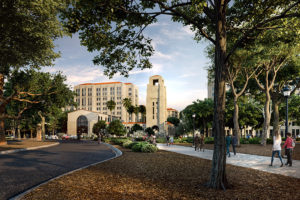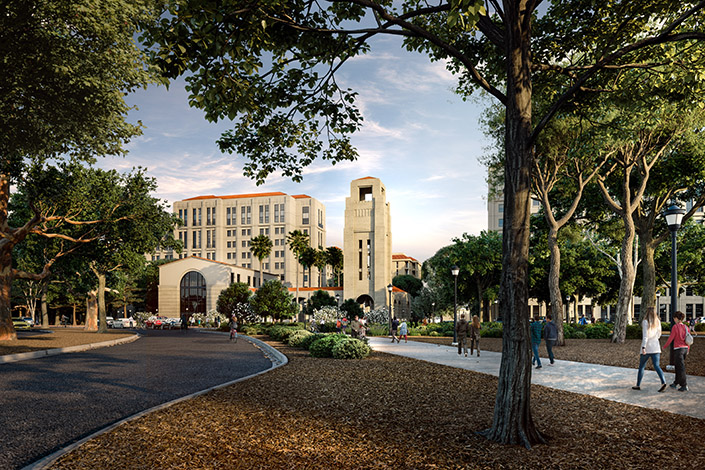At its June meeting last week, the Board of Trustees approved what the Board chair called a “very conservatively constructed” University budget for the coming fiscal year as well as a three-year plan for investment in facilities that is largely devoted to growing housing. The Board also green-lighted next steps on a host of construction projects.
Additionally, the June meeting marked the end of outgoing chair Steven Denning M.B.A. ’78’s five-year tenure, as Jeff Raikes ’80 takes his place heading the Board. Raikes, a veteran of tech, business, and philanthropy who served as CEO of the Bill and Melinda Gates Foundation, has been a Stanford trustee since 2012.
Raikes, who has spent the last few months shadowing Denning and going on a “listening tour” to visit dorms and meet student, staff and faculty leaders, highlighted the University’s long-range planning process, Stanford Medicine and the unique housing and transportation challenges of the Bay Area as key areas he foresees working on as chair of the Board. Above all, though, he and Denning both emphasized a desire to capitalize on Stanford’s capacity for leadership among universities and in the world.
Despite these big aspirations, Denning said that Stanford’s budget for the 2017-18 fiscal year beginning Sept. 1 is “cautious,” partly due to sluggish growth in endowment returns and uncertainty over the future of federal research funding, a major source of revenue for the University.
The coming fiscal year’s $6.3 billion budget, nearly 7 percent larger than the previous year’s, projects a surplus of $165 million.
The budget allots $20 million in “contingency funding” to cover any money shortfalls well as to fund what Denning called “experimentation” under the recently launched long-range planning process, which will map out a vision for Stanford’s growth over the next decade and beyond.
The new budget’s relatively conservative approach follows similar concerns about federal money surrounding last year’s budget, which former Provost John Etchemendy Ph.D. ’82 declared the “most sobering” the University had seen since 2009 due to a drop in government research funding.
According to Denning, Stanford President Marc Tessier-Lavigne has been focusing recently on communicating the importance of sustained government support for research: Tessier-Lavigne joined leaders in the biotech industry to meet with the vice president and other White House figures in April, and he will return to Washington, D.C. next week.

In addition to the budget, the Board approved the University’s capital plan, which governs the next three years of spending on physical campus improvements. According to Denning, the $4.3 billion capital plan is the largest in Stanford’s history, up from $4.1 billion last year.
Almost half of the capital plan is devoted to increasing housing for graduate students, faculty and staff as part of ongoing efforts to address a shortage of living space on and near campus – a shortage made more critical by high housing prices in the surrounding area.
A major item in the University’s housing plans is residential construction in Escondido Village, which will add over 2,000 net new beds for graduate students as well as 900 parking spots. Construction begins this November; the project is expected to finish in fall of 2020.
Trustees authorized next actions on a variety of other projects-in-progress.
The Board gave concept approval to the Middle Plaza project, which seeks to turn about eight acres of vacant lots into 215 units of faculty and staff housing as well as retail and office space. The development still needs permission to move forward from the Menlo Park City Council.
In another move to add housing, the Board also authorized the concept and site of a plan to tear down two unused on-campus homes and replace them with eight single-family houses.
Plans for a new center for the Emergency Operations Center (EOC) and Electronic Communications Hub (ECH) are set to move forward following concept and site approval. The EOC’s current location at the Faculty Club is problematic because its space is cramped, fails earthquake safety requirements and takes four hours of setup. The new two story building combining the EOC and ECH will be located near a new building for the Department of Public Safety, which received design approval from trustees as the meeting.
Design approval also went to a new childcare center, expansions of the Environmental Health and Safety Facility and the Center for Academic Medicine, the first of two planned buildings in the School of Medicine that will add administrative and research space.
The Board gave its construction approval to the renovation of Frost Amphitheater, which Denning said was delayed to allow baby birds nesting in the venue’s trees to fledge. The renovation will increase Frost’s bathrooms and disability access as well as install a permanent stage that should simplify setup for performances and allow the venue to host up to 50 performers per year.
Trustees heard presentations from the director of the Hoover Institution and from the CEO of the Stanford Management Company, which oversees the University’s endowment. Finally, the Board also honored two trustees who are retiring from the group: Brook Byers M.B.A. ’70, who served a five-year term, and Susan McCaw ’84, a trustee for a decade.
Reflecting on his time as chair as he moves on, Denning said that “there are very few things that we’ve started and brought to life” during his five-year term; much of Board’s work consists of seeing existing projects through, he said.
However, he noted three areas of work that he is especially proud of.
He highlighted the Board’s selection of University President Marc Tessier-Lavigne, now a year into his role, as well as its work in creating the Knight-Hennessy Scholars program, which will bring graduate students from around the world to Stanford on scholarship starting in 2018. Denning noted the quick success of the program with fundraising: It gathered $750 million within about seven months, a feat he called “kind of unheard of in the development world.” Trustees just gave construction approval to the Denning House, which will serve as hub for the Knight-Hennessy Scholars.
Denning also expressed particular pride in the construction of an “arts district” on campus with the addition of Bing Concert Hall, the McMurtry Building and the Anderson Collection.
“I think it’s one of the huge changes at Stanford,” Denning said.
Contact Hannah Knowles at hknowles ‘at’ Stanford.edu.
